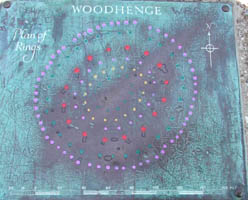Introduction
The standing stones in England are almost countless. Saying that, I am sure someone does have the count, but to us, there are more than we could ever see. Perhaps the most known is Stonehenge, but close to that are Avebury Stone Circle which is amazing, though less visited, and wood henge, which amazingly you can visit.
Stonehenge

Parts of stonehenge were built about 3050 B.C. This part is a large circular ditch and bank that surrounds the area. This is what is called a henge. Around 2500 B.C. a wooden structure was build in the center. You can not see remains of this today. Between 2500 and 1500 B.C. The stone monument was constructed and rearranged.


On the left images you see the Circle of Sarsen. It is made up of the tall stones that have a horizontal row resting on top of the pillars. They came from the Marlbourough Downs which is about 18 miles away. The small vertical stones in front of it are part of the circle of bluestones which are from the Presili mountains in Wales which are about 230 miles away.
The second photo (right) shows part of the Horseshoe of Trilithons which are inside the bluestones mentioned above. You can also see smaller stones inside the horseshoe. They are also bluestone

Woodhenge
Possible Bronze Age, possible for religious/ceremonial use, etc, this site consists of cement markers where wooden poles once stood. The ring of timber was actually oval in shape where the long axis aligned with the midsummer sunrise.
When we went to visit this site, there was another couple visiting. There is nearby areas where it is nice to sit and have a picnic lunch.
Hayhenge

Just kidding!

